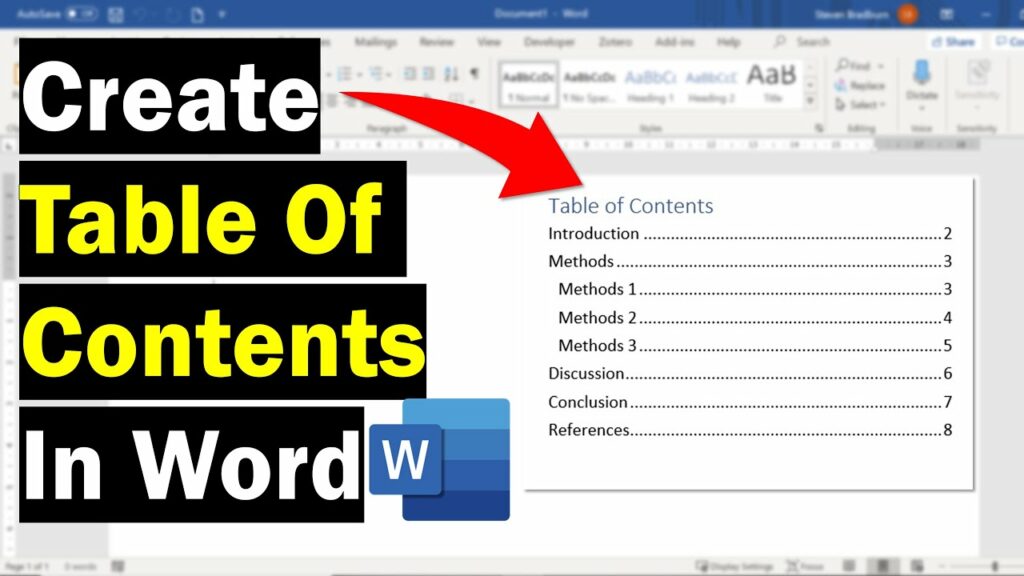Navigating Content: A Comprehensive Guide to Creating a Table of Contents in Microsoft Word

In the expansive realm of document creation, organization is key to presenting information in a clear, structured, and easily navigable manner. Whether you’re writing reports, academic papers, or lengthy documents, a table of contents (TOC) serves as an indispensable tool for guiding readers through the content and helping them locate specific sections or topics with ease. In this extensive guide, we’ll explore the intricacies of creating a table of contents in Microsoft Word, empowering you to organize your documents effectively and enhance their usability and readability.
Understanding the Significance of a Table of Contents:
Before delving into the practical aspects of creating a table of contents, it’s crucial to grasp the significance of this navigational aid in document organization and navigation. A table of contents serves multiple purposes, including:
- Providing an overview: A table of contents offers readers a concise overview of the document’s structure, highlighting key sections, chapters, or topics and their respective page numbers.
- Facilitating navigation: A table of contents enables readers to quickly locate specific sections or topics within the document, saving time and effort in information retrieval.
- Enhancing usability: A well-designed table of contents enhances the usability and readability of the document, improving the overall user experience and engagement.
By incorporating a table of contents into your document design, you can create documents that are not only informative and comprehensive but also user-friendly and accessible.
Basic Table of Contents Creation:
Creating a table of contents in Microsoft Word is a straightforward process that can be accomplished using built-in tools and features. Here’s how to do it:
- Insert Headings:
- Structure your document using hierarchical headings to delineate sections, chapters, or topics. Use Heading 1 for main sections, Heading 2 for subsections, and so on, to establish a clear hierarchy.
- Place Cursor:
- Position the cursor at the location in the document where you want to insert the table of contents. This is typically at the beginning of the document, but you can place it anywhere you prefer.
- Access Table of Contents Menu:
- Navigate to the “References” tab located in the top menu bar of Microsoft Word.
- In the “Table of Contents” group, you’ll find the “Table of Contents” button. Click on this button to access the table of contents menu.
- Select Table of Contents Style:
- In the table of contents menu, you’ll see options for different table of contents styles, such as “Automatic Table 1” or “Manual Table.” Choose the style that best suits your document design preferences.
- Insert Table of Contents:
- After selecting the desired table of contents style, click on the option to insert the table of contents into your document. The table of contents will be generated automatically based on the headings and their corresponding page numbers.
Advanced Table of Contents Options:
While basic table of contents creation suffices for most scenarios, Microsoft Word offers advanced features and customization options to further enhance the functionality and appearance of the table of contents. Here are some additional features you may explore:
- Customizing Table of Contents Styles:
- Word allows users to customize the appearance of the table of contents by modifying styles, fonts, colors, and formatting options. To customize table of contents styles, navigate to the “References” tab, then click on “Table of Contents” and select “Custom Table of Contents” from the dropdown menu.
- Updating Table of Contents Automatically:
- Word offers options for updating the table of contents automatically when changes occur in the document, such as adding or removing headings or pages. To update the table of contents, right-click on it and select “Update Field” from the context menu.
- Formatting Table of Contents Entries:
- In addition to automatic generation, Word allows users to manually format table of contents entries, such as adjusting indentation, spacing, and alignment. Use the “Modify” button in the table of contents menu to access formatting options.
Best Practices for Table of Contents Usage:
While table of contents offer invaluable assistance in document navigation and organization, it’s essential to use them judiciously and in accordance with best practices. Here are some tips to consider:
- Keep it Concise:
- Limit the table of contents to essential sections or chapters to avoid overwhelming the reader with excessive detail. Include only major headings and subheadings that are relevant to the document’s structure and content.
- Maintain Consistency:
- Use consistent formatting and styling for headings throughout the document to ensure uniformity in the table of contents. Consistent formatting enhances readability and clarity.
- Update Regularly:
- Regularly update the table of contents to reflect any changes or additions to the document. Ensure that page numbers are accurate and headings are correctly listed to provide reliable navigation for the reader.
- Test Navigation:
- Before finalizing your document, test the navigation functionality of the table of contents to verify that readers can easily navigate to the specified sections or topics. Ensure that hyperlinks are functional and lead to the correct destinations.
Conclusion:
Creating a table of contents in Microsoft Word is a fundamental skill for organizing and navigating documents effectively. By mastering the basic creation process, exploring advanced options, and adhering to best practices for usage, you can create documents that are not only well-structured and comprehensive but also user-friendly and accessible. Whether you’re writing reports, academic papers, or lengthy manuscripts, a table of contents offers a versatile and powerful means of guiding readers through your document with clarity and ease. So, the next time you embark on a document creation journey in Word, remember to leverage the power of a table of contents to enhance document organization, usability, and readability, and make a lasting impression on your audience.





